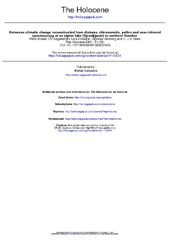Holocene climatic change reconstructed from diatoms, chironomids, pollen and near-infrared spectroscopy at an alpine lake (Sjuodjijaure) in northern Sweden
Peer reviewed, Journal article
Permanent lenke
https://hdl.handle.net/1956/2504Utgivelsesdato
2001Metadata
Vis full innførselSamlinger
Originalversjon
https://doi.org/10.1191/095968301680223503Sammendrag
The results of a multiproxy study reconstructing the climate history of the last 9300 years in northern Sweden are presented. It is based on diatom, chironomid and pollen analyses, as well as near-infrared spec troscopy (NIRS), of a radiocarbon dated sediment core from Sjuodjijaure (67°22N, 18°04E), situated 100 m above tree-line in the Scandes mountains. Mean July air temperature was reconstructed using transfer functions established for the region. The biological proxies show significant changes in composition during the Holocene and the inferred temperatures all follow the same general trend. For the period between about 9300 to 7300 cal. BP the reconstructions should be interpreted with caution due to the lack of convincing modern analogues in the training set. However the reconstruction suggest that July temperature was on average about the same as today, with several rapid short-term cold and warm periods. Cold periods were dated to about 8500, 8200 and 7600 cal. years BP and a warm period to about 7700 cal. BP. About 7300 cal. BP, a major shift to a warmer climate occurred. Pine migrated into the area, which was previously covered with birch forest. From the mid-Holocene until today the sediment record suggests a descending tree-limit and a gradual lowering of July temperature.
